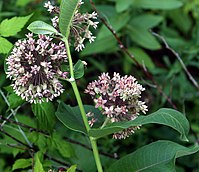Forb

A forb or phorb is an herbaceous flowering plant that is not a graminoid (grass, sedge, or rush). The term is used in biology and in vegetation ecology, especially in relation to grasslands[1] and understory.[2] Typically these are dicots without woody stems.
Etymology
The word "forb" is derived from Greek phorbḗ (φορβή), meaning "pasture" or "fodder".[3][4] The Hellenic spelling "phorb" is sometimes used, and in older usage this sometimes includes graminids and other plants currently not regarded as forbs.
Guilds
Forbs are members of a guild—a group of plant species with broadly similar growth form.[5] In certain contexts in ecology, guild membership may often be more important than the taxonomic relationships between organisms.

In informal classification
In addition to its use in ecology, the term "forb" may be used for subdividing popular guides to wildflowers,[6] distinguishing them from other categories such as grasses, sedges, shrubs, and trees.[7] Some examples of forbs are clovers, sunflowers, daylilies, and milkweed.
Examples
Linnaean taxonomy family names are given.[8] Acanthaceae, Aizoaceae, Amaranthaceae, Apiaceae, Apocynaceae, Asclepiadaceae, Asteraceae, Balsaminaceae, Begoniaceae, Boraginaceae, Brassicaceae, Buxaceae, Campanulaceae, Cannabaceae, Caryophyllaceae, Chenopodiaceae, Clusiaceae, Convolvulaceae, Crassulaceae, Cucurbitaceae, Cuscutaceae, Dipsacaceae, Ericaceae, Euphorbiaceae, Fabaceae, Gentianaceae, Geraniaceae, Gunneraceae, Haloragaceae, Hydrophyllaceae, Lamiaceae, Lentibulariaceae, Limnanthaceae, Linaceae, Lythraceae, Malvaceae, Moraceae, Nyctaginaceae, Onagraceae, Orobanchaceae, Oxalidaceae, Papaveraceae, Phytolaccaceae, Plantaginaceae, Plumbaginaceae, Polemoniaceae, Polygonaceae, Portulacaceae, Primulaceae, Ranunculaceae, Resedaceae, Rosaceae, Rubiaceae, Scrophulariaceae, Solanaceae, Thymelaeaceae, Urticaceae, Valerianaceae, Verbenaceae, Violaceae, Zygophyllaceae
See also
- Dicotyledon – Historical grouping of flowering plants
- Herbaceous plant – Plant that has no persistent woody stem above ground
- Overgrazing – When plants are grazed for extended periods without sufficient recovery time
References
- ^ Schröder, Hans (2009). Grasslands: Ecology, Management and Restoration. Commack, N.Y: Nova Science Publishers. ISBN 978-1-60692-024-4.
- ^ "Native Understory Forbs and Grasses". www.nrcs.usda.gov.
{{cite web}}: CS1 maint: url-status (link) - ^ Jaeger, Edmund C. (1959). A source-book of biological names and terms. Springfield, Ill: Thomas. ISBN 0-398-06179-3.
- ^ Scott, Robert Pickett; Henry, George (2007). Liddell and Scott's Greek-English Lexicon, Abridged: Original Edition, republished in larger and clearer typeface. Simon Wallenburg Press. ISBN 978-1-84356-026-5.
- ^ Roxburgh, Stephen. A Demonstration of Guild Based Assembly Rules for a Plant Community and Determination of Intrinsic Guilds.
- ^ "Wildflower seeds and forbs". graniteseed.com. Retrieved 2021-05-02.
- ^ "Describe the major differences between the plant families used as forages". Forage Information System. 2009-05-28. Retrieved 2021-05-02.
- ^ "Invasive Plant Atlas". Retrieved 25 Sep 2021.
External links
- United States Department of Agriculture Natural Resources Conservation Service link to Growth habits Codes and Definitions.
